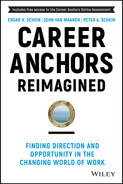7
What's Next? Growth Intentions
Dr. Seuss:
“You'll get mixed up, of course,
As you already know.
You'll get mixed up
With many strange birds as you go.
So be sure when you step.
Step with care and great tact
And remember that Life's
A great Balancing Act.”
One of the reactions that is common after going through the career anchors process is surprise, which then triggers seeming contradictions. Part of you feels one way, and the career anchors results may lean another way.
We may all feel like entrepreneurs or CEOs, but when we go through the mapping, interview, and assessment, it gets more complicated, more nuanced. Generally speaking, by looking at relationship maps, interview transcripts, and the online assessment you may do a better job of capturing where you were and where you might want to be as you look ahead.
The next and final step in an assessment of your career is to get a sense of how you would like your career to develop and what you might do to bring it about. To this end, the growth survey should provide you with ideas about how your own work and life situation could unfold as you look ahead.
Your Own Growth Profile
When you registered with the online system, you should have received an invitation that directs you to another phase of assessment:
This part of the career assessment is structured similarly around the 32 items that you reacted to in the last chapter, from not very important to very important. But, this time, these items are focused on growth with the statements phrased as career growth objectives:
“To realize my career aspirations, I think I need to improve…”
Examples of the kinds of growth statements you will respond to are:
- I need to become better at figuring out how things work and how to fix things myself.
- I need to be more willing to integrate both the challenges of work and family.
- I need to continuously develop my specialized knowledge and skills.
Similar to the Career Anchors assessment as outlined in Chapter 6, you will react to these statements on this 0–3 scale, but here the assessment is gauging the relative importance of the growth objective. If the growth intention is not important at all, you would score it “0,” “1,” and so on, according to this four‐point scale:
| 0 | Not Important |
|---|---|
| 1 | A little |
| 2 | A lot |
| 3 | Critically Important |
Once you have gone through the 32 career growth or skills development items, a now familiar “spiderweb” will provide you with a visual perspective on what is important to you and what is not. These growth items are organized around the same eight anchor categories so you can compare your anchor assessment with your growth intentions or aspirations.
This would be a good time to take the Growth Intentions assessment. You will get the now familiar spiderweb chart overlaid on your career anchors preferences chart. For interpretive purposes, it helps to have an example as a guide.
Returning to our career example Jamal Rodgers, we can see that his growth intentions (the dotted line) departs in some ways from his anchors (the solid line). Our interpretation of the anchors and growth intentions follows below (Exhibit 7.1).

Exhibit 7.1 Jamal's Career Anchors and Growth Intentions
Looking at the dotted line representing the growth intentions, we can see a theme emerging that Jamal feels the need to develop Entrepreneurial skills, become more comfortable in Autonomous work situations, and develop some General Management competency. He does not feel any need to work on Service as the beginning of his career was entirely devoted to public service. This is not to say that Service is no longer important to Jamal. Rather, the growth intentions (dotted line) suggests where Jamal believes he needs to grow for the next phase in his career journey.
